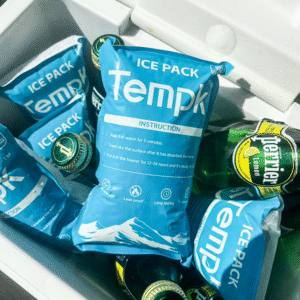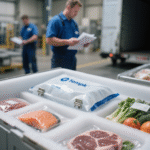How to Pack Dry Ice in Cooler Safely in 2025
If you’re searching how to pack dry ice in cooler, here’s the fast answer: use a dry‑ice‑compatible hard cooler, place blocks on top of items with a cardboard barrier, vent the cooler, and size ice by trip length. Dry ice sits near −109 °F (−78,5 ° C); the airline limit remains 2.5 kg (5.5 kg) per passenger dans 2025.
-
How to pack dry ice in cooler for max hold time and safe venting
-
How much dry ice for a 50‑quart cooler (blocks vs. boulettes)
-
How to pack dry ice in cooler for flights and couriers (2025 rules)
-
Whether you should mix dry ice and regular ice, and how
-
How to pack dry ice in cooler for outages, camping, and road trips
How to pack dry ice in cooler safely—what actually works?
Réponse courte: Put dry ice on top with a cardboard or rack barrier, keep the cooler vented, and pack tightly to remove air gaps. Blocks last longer than pellets, and pre‑chilling the cooler saves hours of hold time. Use insulated gloves and avoid airtight seals to prevent CO₂ pressure buildup.
Why this setup wins: Cold CO₂ sinks, so top placement “washes” the load in freezing air. A barrier prevents freezer burn and protects plastic liners. Tight packing reduces convection that burns through ice. In field tests, properly packed 50‑qt rotomolded coolers kept contents frozen for ~40–52 hours in summer conditions when opened sparingly.
How much dry ice for 50‑quart cooler?
Utiliser 10–15 lb per 25 qt per 24 h for frozen performance; ~5–10 lb for chilled. For a 50‑qt family cooler, plan 20–30 lb per day frozen and add 20–30% buffer for heat or frequent lid opens. Blocs > boulettes for longevity.
| Planning target | 24 h (frozen) | 48 h (frozen) | Ce que cela signifie pour vous |
|---|---|---|---|
| 25‑qt cooler | 10–15 lb | 20–25 lb | Overnight deep‑freeze |
| 50‑qt cooler | 20–30 lb | 40–50 lb | Weekend trip, minimal lid opens |
| 75–100 qt | 30–40 lb | 60–80 lb | Multiday hunts or bulk prep |
Pro tips that extend hold time
-
Préchauffeur the cooler 12–24 h; dump meltwater before packing.
-
Remplir les vides with paper/towels; less air = slower sublimation.
-
Two‑cooler strategy: one “frozen,” one “day‑use” to cut openings.
Real case: A 50‑qt rotomolded cooler with 25 kg of blocks, cardboard base, and few openings held ≤10 °F for ~40 h, rising to 28 °F by ~52 h in 92 °F ambient.
How to pack dry ice in cooler for flights and couriers (2025 rules)?
Direct answer: Cap at 2.5 kg (5.5 kg) per passenger/package, use vented packaging, and mark “Dry ice / Carbon dioxide, solid” with net mass. Airlines require approval; couriers require UN1845 marking and non‑airtight designs. Keep dry ice separated from food by a barrier and secure the load.
What to do: Choose a small ventable hard cooler, place dry ice on top, add a barrier, and avoid gasket‑tight seals. For ground shipping, design vent paths and show Kg net on the label; for air travel, confirm airline approval on your reservation. These requirements remain current in 2025.
Can you fly with dry ice 2.5 kg?
Oui-≤2.5 kg per passenger in carry‑on or checked bags, avec airline approval, ventilation, and proper marking. If you need more cold mass, split into multiple compliant packages or combine with PCMs for non‑frozen lanes.
| Travel step | Do this | Why it matters | Pour toi |
|---|---|---|---|
| Quantity | Keep ≤2.5 kg per person | Meets FAA/IATA baseline | Avoids check‑in refusals |
| Ventilation | Crack lid or drain plug | Prevents CO₂ pressure | Safety for cabin/hold |
| Marquage | “Dry ice / UN1845” + Kg net | Required for handlers | Faster acceptance |
| Placement | Blocs sur le dessus + barrier | Even freezing, protects liners | Longer hold time |
How to pack dry ice in cooler with regular ice—does mixing help?
Oui. Place dry ice below with a separator, then regular ice above to fill gaps. The dry ice keeps water ice solid longer while protecting items that should stay cold, not rock‑hard. Mettre drinks farthest from dry ice to avoid freezing; pack firmly to prevent flash‑freeze of produce.
Prevent freezing drinks with “zone packing”
Build zones: frozen zone nearest dry ice, tampon at mid‑height, et chilled zone for beverages far from the dry ice. Baskets or racks keep sensitive items off the cold deck. This lets one cooler serve both frozen and chilled needs without sacrificing safety.
How to pack dry ice in cooler for outages and road trips?
Sort items first. Freeze hard anything that must stay frozen. Pré-Chill la glacière, then layer cardboard base → payload → barrier → blocks on top. Vent slightly during driving and avoid sealed cabins; crack windows to prevent CO₂ buildup. Use a probe thermometer and keep chilled foods ≤40 °F.
Car ventilation and safety
Do not trap a venting cooler in a sealed trunk or tent. CO₂ is odorless and displaces oxygen. Transport in a ventilated area and store coolers out of small rooms. Insulated gloves are mandatory; frostbite happens fast at dry‑ice temperatures.
2025 glace carbonique & cold chain trends—what’s changing?
Trend snapshot: CO₂ supply tightness makes early procurement wise in peak seasons, alors que reusable shippers and PCM packs are expanding for 2–8 °C and −20 °C lanes. Dry ice remains the top choice for frozen et ultracold utiliser, but smart routing, VIP insulation, and monitoring reduce required pounds per trip.
Dernier progrès en un coup d'œil
-
Air travel rules unchanged: 2.5 kg limit per passenger/package with venting and clear marking.
-
Blocks over pellets: longer hold time for coolers; pellets for fast pull‑down.
-
Two‑cooler strategy: fewer openings = less sublimation and better user safety.
Perspicacité du marché: Expect regional price and availability swings; plan re‑ice points on long routes. For many chilled deliveries, high‑performance PCMs cut cost and simplify compliance when −78.5 °C is not required.
FAQ
Q1: What’s the single best practice for how to pack dry ice in cooler?
Mettre blocks on top with a cardboard barrier, vent the cooler, et fill air gaps. This balances freezing power with safety.
Q2: How long does 10 lb of dry ice last in a 25‑qt cooler?
À propos 24 heures under normal use; hotter weather or frequent openings shorten this. Add a 20–30% buffer.
Q3: Will dry ice crack my cooler?
It can if the model isn’t rated. Stick to rotomolded hard coolers approved for dry ice and use a barrier to protect liners.
Q4: Is it safe to mix dry ice and regular ice?
Yes—separate them with cardboard. Dry ice keeps water ice solid longer while protecting items you don’t want frozen.
Q5: Can I ship food with dry ice?
Oui. Use vented packaging, marque UN1845 avec Kg net, and place dry ice on top of the payload inside the shipper.
Résumé & recommendations
Points clés: To master how to pack dry ice in cooler, utiliser blocks on top + barrier, vent the cooler, and size ice using 10–15 lb per 25‑qt per day for frozen goals. Pre‑chill everything and reduce lid opens. For flights, follow the 2.5 kg rule and required markings.
Action plan:
-
Confirm your cooler is dry‑ice compatible.
-
Use the estimator below to size your order.
-
Paquet base → payload → barrier → blocks and vent slightly.
-
Monitor temperature and plan re‑ice points.
CTA: Want a tailored pack plan? Book a free 15‑minute consult with Tempk.
À propos du tempk
We design practical, compliant packouts for food, biopharma, and specialty goods. Our calculators and playbooks reflect current FAA/IATA/PHMSA rules and brand‑specific cooler guidance, validated with field tests. The goal: Moins de surprises, longer hold times, and simpler compliance.
Next step: Talk to our cold‑chain team for a free packout review.
























